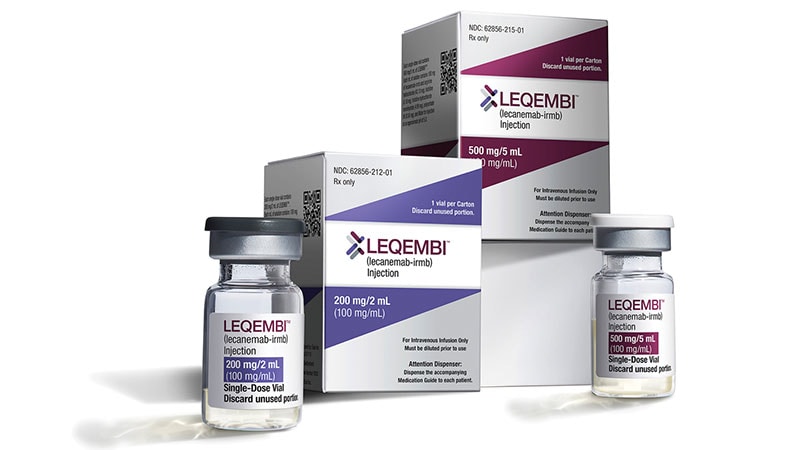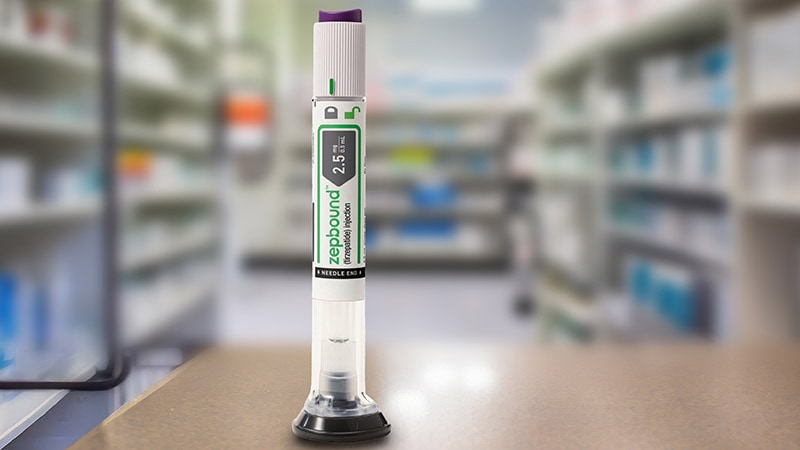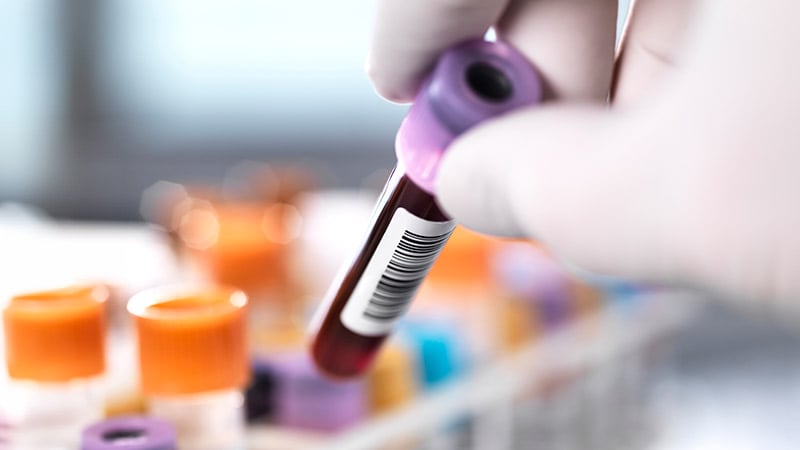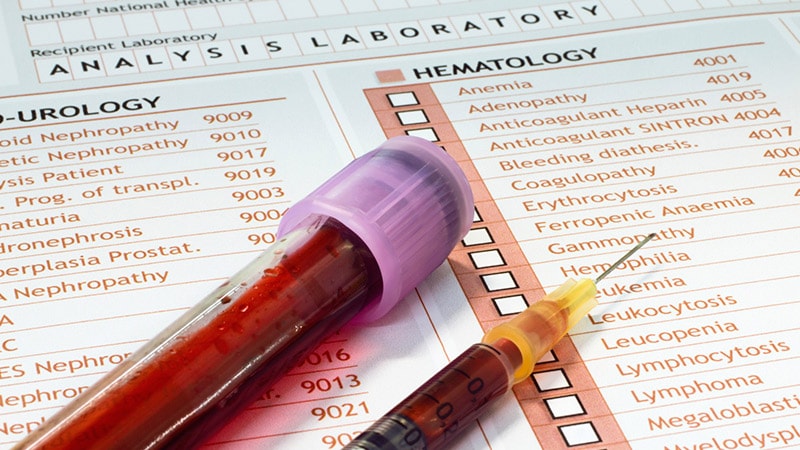Presentation
A 65-year-old woman presented for her annual physical examination with concerns of recent unintended weight loss and fatigue over the past 3 months. Past medical and family history were noncontributory. The patient reported no recent history of fevers, infections, or changes in medication. Clinical examination revealed palpable splenomegaly which prompted further evaluation. Autoimmune serology returned negative. Initial laboratory tests showed an elevated white blood cell count (> 40,000 cells/µL) with low leukocyte alkaline phosphatase (LAP) levels.
Differential Diagnosis
Several disorders must be considered before making a diagnosis.
Splenomegaly should be assessed by palpating the spleen and measuring its size in centimeters below the costal margin. Autoimmune disorders like systemic lupus erythematosus or rheumatoid arthritis can show splenomegaly and cytopenia; however, autoimmune serology can quickly rule these out, as was done in this patient.
It is important to rule out possible causes of the increase in white blood cells (leukocytosis), such as infections or certain drugs. Most reactive leukocytosis shows white blood cell counts below 50 x 109/L and exhibits toxic alterations such as granulation and Döhle bodies. There will also be an absence of basophilia and normal or increased LAP levels. The origin of the leukemoid reaction can be determined by clinical history and physical examination. Although corticosteroids can cause neutrophilia with a left shift, this abnormality is transient and of short duration.
Peripheral blood and bone marrow findings can help differentiate possible myeloproliferative disorders, including:
- Acute myeloid leukemia (AML)
- Essential thrombocytosis
- Myelodysplastic syndrome
- Myeloproliferative disease
- Polycythemia vera
- Primary myelofibrosis
- Chronic myelogenous leukemia (CML)
Further Evaluation
Peripheral blood smear showed leukoerythroblastic blood picture (peripheral blast cells 10%); bone marrow biopsy showed hypercellularity with expansion of myeloid and myeloid progenitor cells. Cytogenetic studies of metaphase cells showed the presence of the Philadelphia (Ph1) chromosome with reverse transcription polymerase chain reaction (RT-PCR) of both bone marrow and peripheral blood, confirming the presence of BCR::ABL1 transcripts.
Diagnosis
The patient was diagnosed with chronic-phase CML with a low risk category. In CML, peripheral blood findings are positive for leukocytosis, with a slight elevation of eosinophils, basophils, and monocytes. In patients with chronic-phase disease, hypercellular bone marrow, myeloid hyperplasia with a left shift in maturation, and myeloblasts up to 10% are present. LAP can also be used to distinguish CML from other myeloproliferative disorders, particularly myelofibrosis and polycythemia.
The patient was treated with imatinib as primary therapy. Her disease was monitored by RT-PCR international scale for BCR::ABL1 transcripts and met positive early response indicators at 3 and 6 months (6% positive BCR::ABL1 at 3 months, 2% at 6 months).
It is recommended that the initial evaluation of a patient should include a thorough history and physical examination, which includes palpation of the spleen. Additionally, the National Comprehensive Cancer Network (NCCN) guidelines recommend a complete blood count (CBC) with differential, a chemistry profile with uric acid, and a bone marrow aspirate, and a hepatitis B panel should be performed. During the initial workup, bone marrow cytogenetics should be conducted to detect any chromosomal abnormalities in Ph1-positive cells that contain the BCR::ABL1 oncogene.
According to the NCCN guidelines, the most sensitive assay for detecting BCR-ABL1 mRNA is quantitative RT-PCR using the international scale. This test is usually done on peripheral blood and can detect one CML cell among at least 100,000 normal cells. Although BCR-ABL1 transcripts in the peripheral blood exist at deficient levels (1-10 of 108 peripheral blood leukocytes), they can still be detected in around 30% of normal individuals, and this incidence increases with age.
Quantitative RT-PCR is a molecular technique used to measure the amount of specific RNA in a sample. The results of this test can be expressed in different ways, such as the ratio of BCR-ABL1 transcripts to control. To standardize molecular monitoring with RT-PCR across different labs, an international scale has been established. This scale uses one of three control genes (BCR, ABL1, or GUSB) and an RT-PCR assay with a sensitivity of at least 4-log reduction from the standardized baseline.
If bone marrow evaluation is not possible, fluorescence in situ hybridization (FISH) on a peripheral blood specimen can be used with dual probes for BCR and ABL1 genes, although it can result in a false-positive rate of 1%-5%, depending on the specific probe used in the assay.
Management
Tyrosine kinase inhibitors (TKIs) are the standard treatment of choice for newly diagnosed CML patients in all stages of the disease. There are currently six approved TKIs: imatinib, dasatinib, nilotinib, bosutinib, ponatinib, and radotinib (only in South Korea). Imatinib is considered a first-generation TKI; dasatinib, nilotinib, bosutinib, and radotinib are second-generation TKIs; and ponatinib is a third-generation TKI. These TKIs vary in their potency, ability to target BCR-ABL1 mutants, pharmacokinetics, and adverse-event profiles. Patients who develop resistance to primary TKI therapy or are nonresponsive to multiple TKIs should consider enrollment in a clinical trial or consolidation chemotherapy and allogeneic hematopoietic cell transplantation.
The choice of first-line therapy depends on the Sokal or Hasford risk-stratification score, patient's age, ability to tolerate therapy, and medical comorbidities. The Sokal score includes age, spleen size, platelet count, and blast percentage. The Hasford score includes these while also incorporating the percentage of eosinophils and basophils.
Because durable responses can be achieved with single-drug TKIs, monitoring response is essential to ensure that disease progression does not occur. The response to TKI therapy can be determined by examining three factors: hematologic (normalization of peripheral blood counts), cytogenetic (reduction in the quantity of Ph-positive metaphases using bone marrow cytogenetics), and molecular assessments (decrease in the amount of BCR::ABL1 chimeric mRNA using RT-PCR).
The main treatment goal of TKI therapy is a complete cytogenetic response (< 10%; < 1% for second-generation TKIs) by 12 months, alongside achieving complete hematologic response (normalized blood counts and no disease symptoms) and a major molecular response (BCR-ABL1 transcripts ≤ 0.1% on the international scale). BCR::ABL1 PCR < 1% is associated with the longest maintenance and least development of resistance.
Per the NCCN guidelines, patients starting treatment for chronic-phase CML should have initial bone marrow and cytogenetic tests, with follow-up monitoring at 3, 6, and 12 months using RT-PCR on peripheral blood to quantify BCR::ABL1 transcripts and determine TKI sensitivity or resistance to disease. If RT-PCR response milestones have not been reached, bone marrow cytogenetics should be considered.
Prognosis
Before the introduction of TKIs like imatinib, most CML cases progressed to the blast phase, and death occurred in under 5 years. Since their introduction, the 5-year survival has risen from 10% in 2001 to 70.6% between 2013 and 2019. As a result, patients with CML who receive modern therapies have a life expectancy similar to that of individuals without the disease.
Achieving an early molecular response (≤ 10% BCR::ABL1 on the international scale) at 3 and 6 months post-initiation of TKI therapy is a strong indicator of favorable long-term progression-free survival and overall survival. While some studies highlight the superior prognostic value of the 3-month early molecular response for guiding early treatment interventions, other studies show mixed results about its predictive significance at this time point. Practically, the NCCN guidelines advise evaluating BCR::ABL1 levels within the clinical context, suggesting that a patient slightly above the 10% threshold (eg, 11%-15% at 3 months) should be reevaluated at 6 months before making significant treatment adjustments.
Clinical Takeaway
- Differential diagnosis of CML requires careful distinction from other conditions that cause splenomegaly and elevated white blood cells, emphasizing the importance of a comprehensive initial evaluation including spleen palpation, CBC with differential, and specific tests like bone marrow aspirate and cytogenetics to detect the BCR::ABL1 oncogene.
- Management with TKIs is central to CML treatment, highlighting the significance of selecting the appropriate TKI on the basis of patient risk stratification, tolerance, and potential resistance.
- Monitoring treatment response through hematologic, cytogenetic, and molecular assessments is crucial for adjusting therapy to ensure optimal long-term outcomes.
- Improved prognosis with TKI therapy has significantly extended CML patient survival, with early molecular response as a crucial prognostic marker for long-term outcomes.

.webp) 2 weeks ago
13
2 weeks ago
13



























 English (US)
English (US)